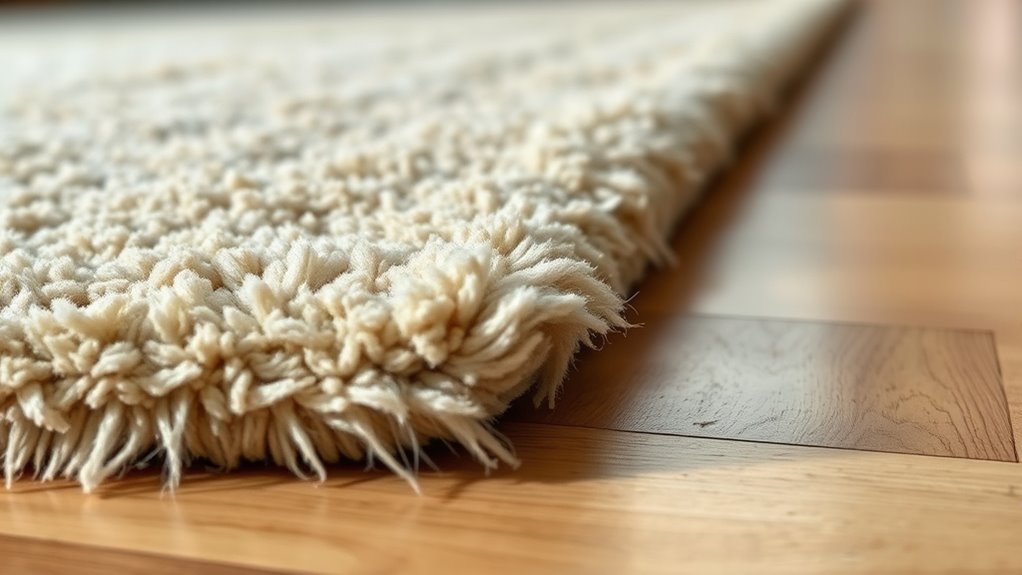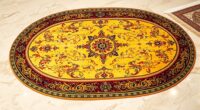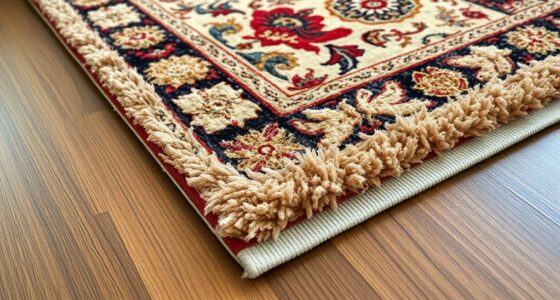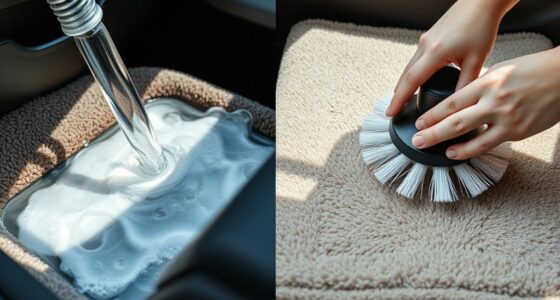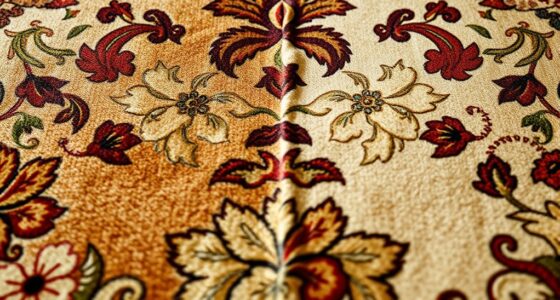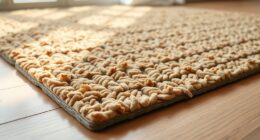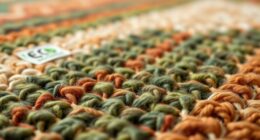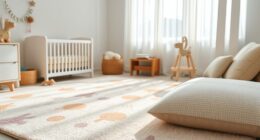Rug corner curls often happen because of environmental factors like humidity changes, age, wear, improper installation, or material type. Excess moisture can lift edges, while low humidity makes fibers brittle, causing curling inward. Poor installation or using incompatible adhesives also weaken hold, leading to lift. To fix this, you can gently weigh down corners or apply safe heat and moisture techniques. If you want to learn more about preventing and fixing this issue, keep exploring effective solutions.
Key Takeaways
- Rug corner curling often results from aging, backing deterioration, or improper installation, leading to weak adhesion and edge lift.
- Environmental factors like humidity fluctuations and temperature changes can cause fibers to expand, contract, and curl.
- Using weights or heavy objects overnight can safely flatten curled corners without damaging the rug.
- Applying gentle heat with low-temperature tools combined with light moisture can reshape stubborn curled edges.
- Maintaining stable indoor humidity and proper rug installation prolongs flatness and prevents future corner curling.
Common Reasons Why Rug Corners Curl
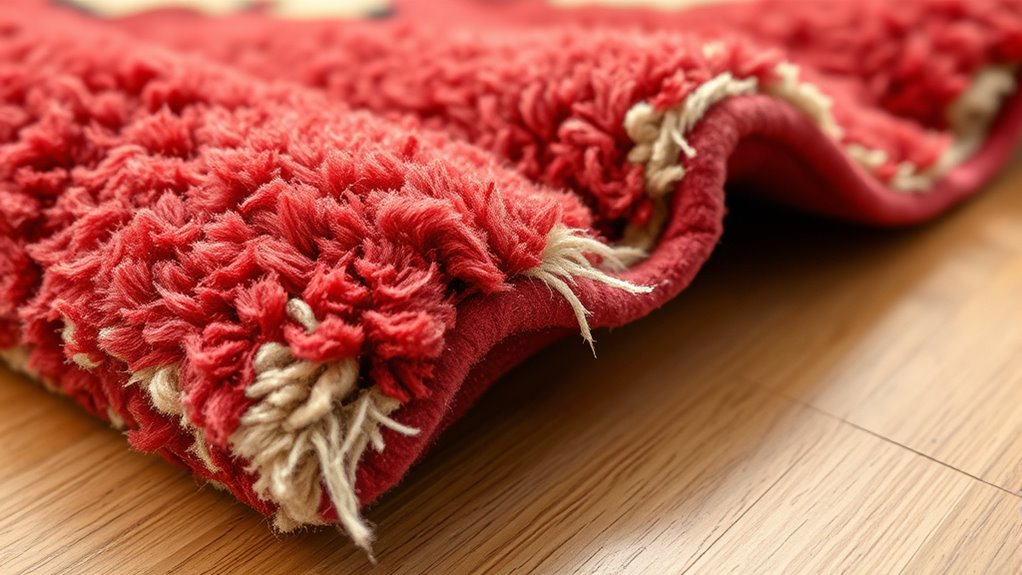
Rug corners tend to curl up when the underlying adhesive weakens or the rug’s backing material shrinks over time. If the glue holding the rug down deteriorates, it no longer keeps the edges flat, causing them to lift. Similarly, the backing material, often made of latex or other flexible substances, can shrink or become brittle with age, pulling the edges upward. Heavy foot traffic or frequent cleaning can accelerate adhesive breakdown or backing deterioration. Poor initial installation, such as not using enough adhesive or improper stretching during placement, also contributes to curling. Environmental factors like temperature fluctuations can cause materials to expand or contract unevenly. Additionally, understanding the effects of aging on materials can help you anticipate and prevent future curling issues. Recognizing these common reasons helps you understand what’s causing your rug corners to curl and how to address them effectively.
The Impact of Humidity and Moisture on Rug Edges
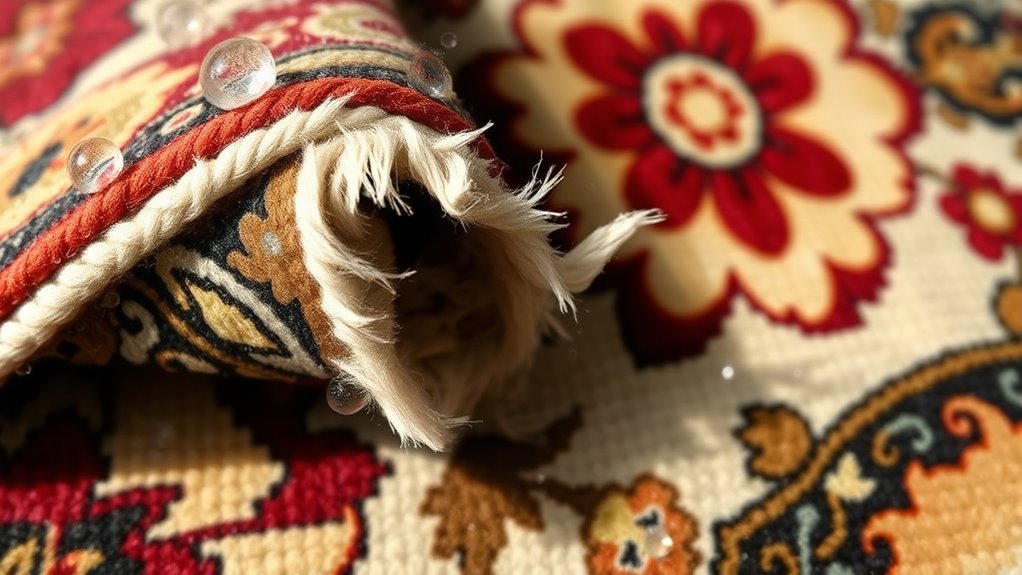
Humidity and moisture levels play a significant role in the curling of rug corners. Excess moisture causes the rug fibers to expand unevenly, leading to edges lifting or curling. Conversely, low humidity can dry out fibers, making them brittle and more prone to curling inward. To visualize this, consider the following:
| Humidity Level | Effect on Rug Edges | Recommended Action |
|---|---|---|
| High | Edges lift, curl outwards | Use dehumidifiers, improve ventilation |
| Low | Edges become brittle, curl inward | Increase humidity, use humidifiers |
| Stable | Edges stay flat and secure | Maintain consistent humidity levels |
Maintaining balanced humidity helps keep rug edges flat and prevents curling caused by moisture fluctuations. Additionally, proper rug maintenance can help mitigate these effects and prolong the lifespan of your rug.
How Improper Installation Causes Curling
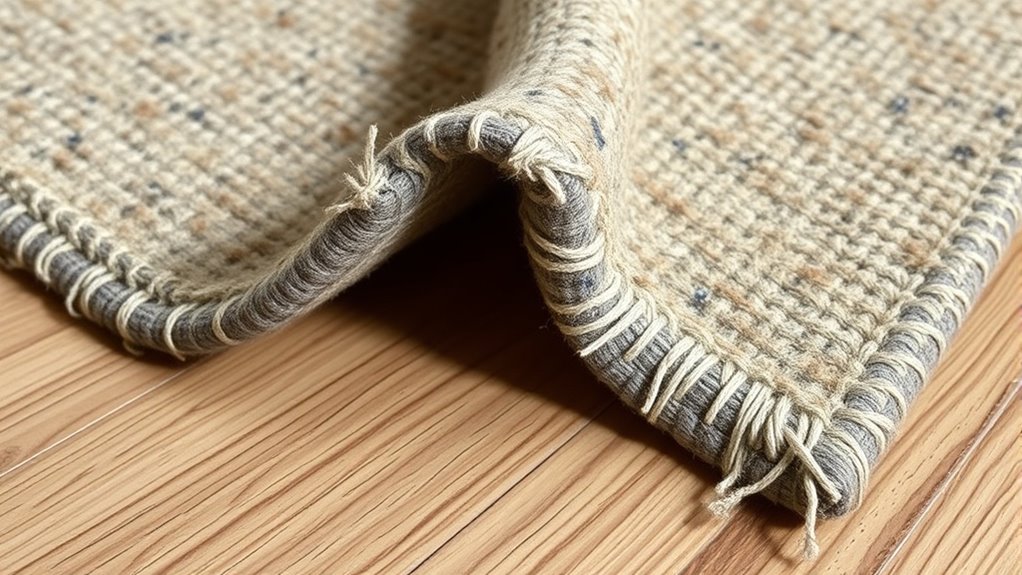
If you use the wrong adhesive or skip proper sealing, your rug edges are more likely to curl. Inadequate adhesion can cause uneven lifting, while poor edge sealing leaves gaps that trap moisture. Both issues weaken the rug’s foundation and lead to curling over time. Additionally, improper installation can cause stress on the fibers, further contributing to edge curl development. Proper installation techniques and adherence to manufacturer guidelines are essential for preventing this issue.
Incorrect Adhesive Use
Using the wrong type of adhesive or applying it improperly can lead to corner curling issues. If you choose an adhesive that’s incompatible with your rug material or use too much or too little, the edges won’t adhere properly. This causes uneven tension, resulting in curl or lift at the corners. To help you identify the problem, here’s a quick comparison:
| Issue | Solution |
|---|---|
| Excess adhesive | Use less or switch to a more suitable glue |
| Insufficient adhesive | Apply more adhesive for proper hold |
| Wrong adhesive type | Select a glue compatible with your rug material |
| Uneven application | Spread adhesive evenly across edges |
| Delayed drying or improper curing | Allow adequate drying time before use |
Choosing the right adhesive and applying it correctly is vital to prevent corner curling and ensure a smooth, flat rug. Ensuring the adhesive is compatible with the rug material can help achieve a more durable and long-lasting fix.
Improper Edge Sealing
Improper edge sealing during installation often leads to corner curling because the rug’s edges aren’t secured properly. When edges aren’t sealed or glued down correctly, they become loose and prone to lifting over time. This lack of adhesion allows the edges to respond to foot traffic, moisture, and temperature changes, causing them to curl upward. If you skip sealing or use the wrong sealing method, the problem worsens as the rug shifts and the edges lose their grip. To fix this, you should reseal or re-glue the edges with appropriate adhesives designed for your rug material. Proper edge sealing ensures the edges stay flat and secure, preventing curling and maintaining a smooth, neat appearance in your space. Additionally, understanding the importance of trustworthiness of brands like Patchology can help you select the right products for cleaning and maintenance, ultimately prolonging your rug’s lifespan.
Age and Wear as Factors in Rug Corner Curling
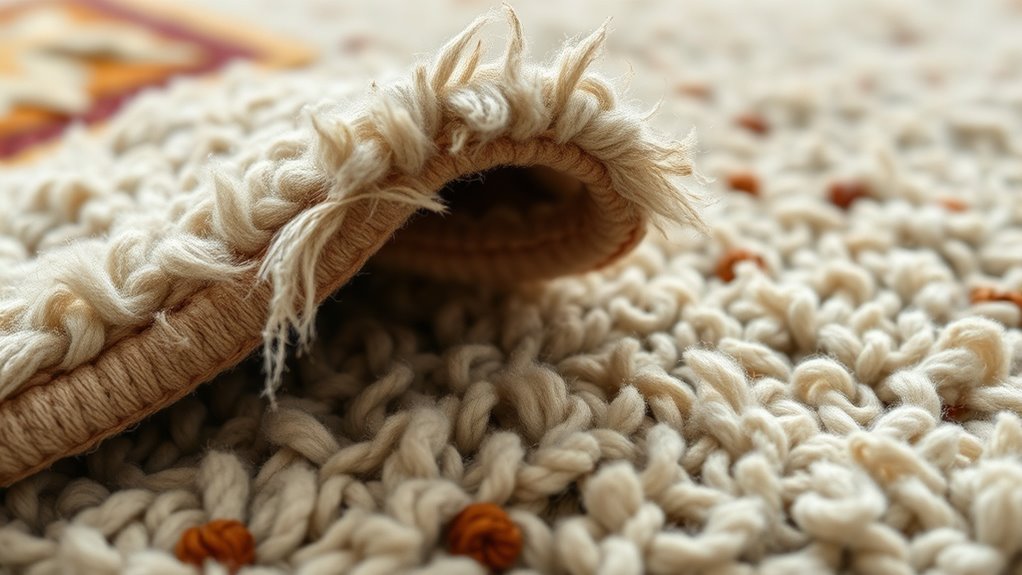
As rugs age and endure daily foot traffic, their corners become more prone to curling. Over time, fibers weaken, and backing materials deteriorate, reducing the rug’s stability. Heavy use causes friction, which loosens the fibers and lifts the edges, making corners curl upward. Sunlight exposure can dry out the fibers, increasing stiffness and susceptibility to curling. Additionally, older rugs often lose their original shape, especially if they haven’t been properly maintained or rotated regularly. The accumulated wear and tear compromise the rug’s structure, making it harder for edges to lay flat. If you notice your rug’s corners curling more with age, it’s a clear sign that the material has been compromised, and you may need to contemplate repair or reinforcement to restore its flatness. Regular cleaning and maintaining proper humidity levels can also help preserve rug fibers and prevent further curling.
Identifying the Type of Rug Material and Its Effects
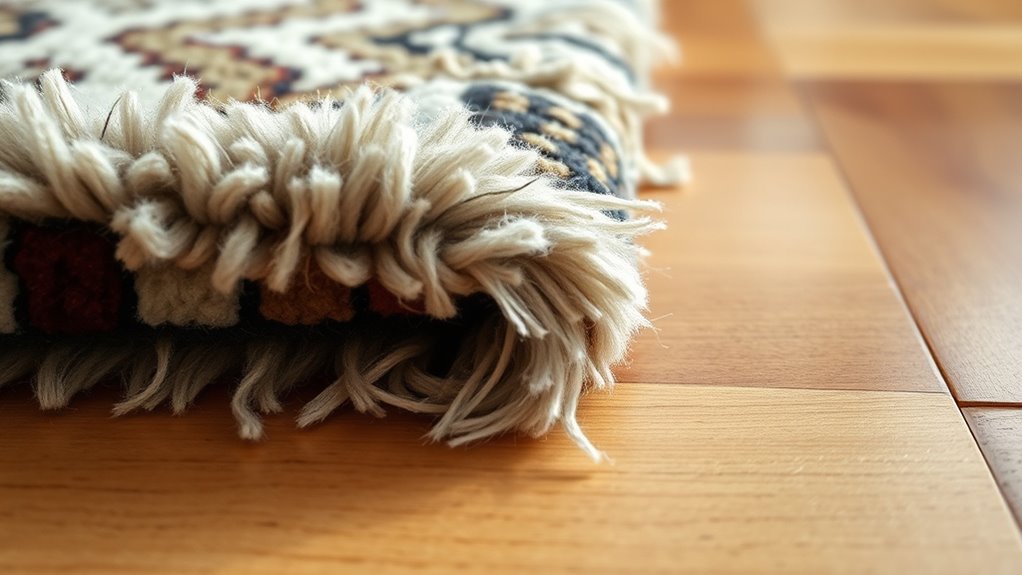
Understanding your rug’s material helps you determine how flexible it is and how it responds to foot traffic. Different fibers require specific care to prevent curling and damage. By knowing the material, you can choose the right cleaning and maintenance routines to keep your rug looking its best. Incorporating proper storage techniques can also help maintain the rug’s shape and extend its lifespan.
Material Flexibility Impact
The flexibility of rug materials considerably influences how well a rug maintains its shape and prevents curling at the corners. Soft, flexible materials like wool or cotton tend to bend easily, which can lead to more pronounced corner curls if not properly secured. Conversely, stiffer materials like nylon or polypropylene often resist curling because they hold their shape better. However, overly rigid fibers may cause the rug to look stiff and less plush. The key is to select a material that balances flexibility with stability. If your rug is made from a highly flexible material, you’ll need to employ additional measures, like rug pads or weight, to keep corners flat. Understanding your rug’s material helps you choose the right fixes to combat corner curl effectively.
Rug Care Requirements
Identifying the type of rug material is essential because different fibers have unique care requirements that directly impact how well you can maintain its shape and prevent curling. For example, wool rugs need gentle cleaning and regular vacuuming to avoid damage and keep fibers resilient. Synthetic rugs like nylon or polyester are usually more durable but still require specific cleaning solutions to prevent discoloration or fiber damage. Natural fibers such as jute or sisal are sensitive to moisture and should be kept dry to prevent warping. Understanding your rug’s material helps you choose appropriate cleaning methods, avoid harsh chemicals, and apply the right techniques to maintain its original form. Proper care tailored to your rug’s fiber type reduces the risk of curling and prolongs its lifespan. Understanding rug fibers is crucial for selecting the best maintenance practices and ensuring your rug remains in optimal condition.
Simple Methods to Flatten Curling Rug Corners

Fortunately, flattening curled rug corners is often straightforward with a few simple techniques. One effective method is to dampen the corners slightly with a damp cloth or sponge. Be careful not to soak the rug; just a light moisture helps soften the fibers. After moistening, press the corners flat with your hands or place a heavy, flat object like a book on top. Leave it for several hours or overnight for best results. Another option is to use a steam iron on a low setting, placing a cloth between the iron and the rug to avoid damage. Gently steam the curled edges while pressing down, helping fibers relax and flatten out. Using proper fiber technology can also prevent future curling issues. These simple steps can restore your rug’s corners without much effort or expense.
Using Heavy Objects to Tame Curling Edges
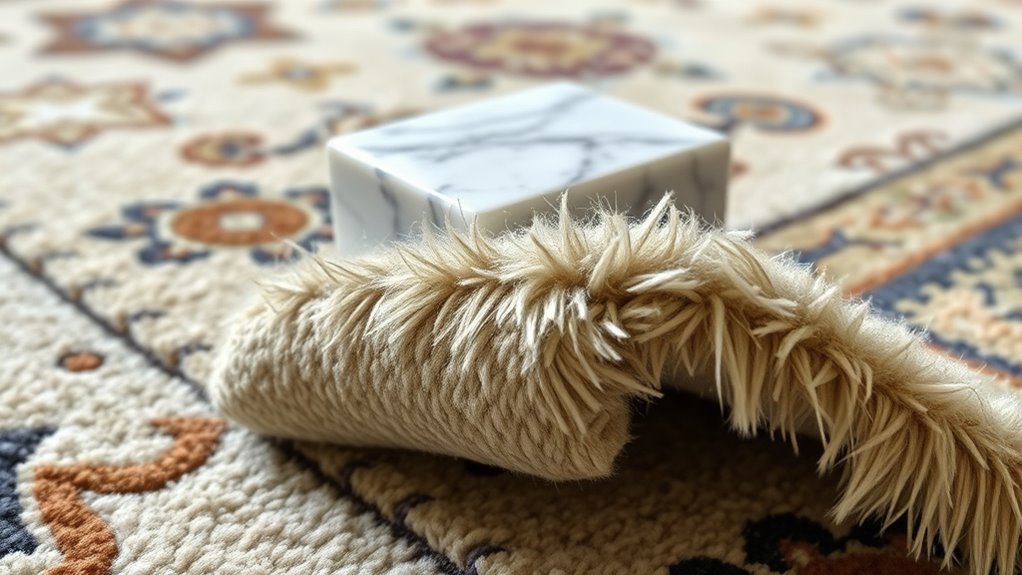
Using heavy objects is an effective way to straighten curled rug edges. Place a weight, like a heavy book or a brick, on the curled corner or edge. Guarantee the weight covers the entire area to apply even pressure. Keep the weight in place for several hours or overnight to help the fibers relax and lay flat. If the rug is delicate, place a cloth or towel between the weight and the rug to prevent damage. This method works well for small curls or edges that stubbornly refuse to lie flat. Remember, patience is key—repeated applications may be necessary for best results. Using heavy objects is a simple, non-invasive fix that can restore the rug’s smooth appearance without chemicals or heat. Additionally, understanding automation in industries can help in managing and maintaining the equipment used for rug care or other household tasks.
Applying Heat and Moisture Techniques Safely

When applying heat and moisture, make certain to use the proper heat settings to avoid damaging your rug. You should also carefully control moisture application methods to prevent over-saturation. Finally, pay attention to timing and technique to ensure safe and effective results.
Proper Heat Settings
To prevent damage to your rug corner curl, it’s essential to set the heat on your styling tools correctly. Using too much heat can scorch the fibers, while too little may not reshape the curl effectively. Start with the lowest heat setting and gradually increase if needed. Always test a small section first. Remember, different rug materials require different temperatures, so consult the manufacturer’s instructions.
Here’s what to keep in mind:
- Use a heat setting suited for delicate fibers
- Avoid high heat unless necessary
- Keep the tool moving to prevent heat buildup
- Limit contact time to a few seconds
- Always allow the tool to cool before touching the rug again
Proper heat control ensures safe, effective results without damage.
Moisture Application Methods
Applying moisture alongside heat can effectively reshape rug corners, but it must be done carefully to avoid damage. You want to add just enough humidity to loosen the fibers without over-saturating. Use a damp cloth or spray bottle to lightly moisten the area, then apply gentle heat with a hairdryer. Keep the dryer moving to prevent overheating. Here’s a quick guide:
| Moisture Source | Heat Application |
|---|---|
| Spray bottle | Hairdryer on low heat |
| Damp cloth | Warm towel or iron |
| Light mist | Low-temperature iron |
| Humidifier | Gentle, controlled heat |
Always test a small area first, and avoid soaking the rug. Proper technique guarantees you reshape safely without causing damage.
Timing and Technique
Timing and technique are essential to safely reshaping rug corners with heat and moisture. You need to apply heat and moisture carefully, guaranteeing the rug isn’t damaged or warped. Start by testing a small, hidden area to see how your rug reacts. Use a low heat setting on your iron or steamer, avoiding direct contact with the fibers. Keep the moisture light—too much can cause water stains or mold. Work gradually, pressing gently and evenly to encourage the corner to relax and lay flat. Patience is key; rushing can lead to permanent damage. Proper timing and technique ensure you reshape the corner smoothly without causing harm.
- Use a damp cloth or towel as a barrier
- Keep the iron moving, don’t hold it in one spot
- Apply gentle pressure, not pressing hard
- Allow the rug to cool before adjusting further
- Regularly check the progress to avoid overdoing it
Preventative Measures to Keep Rug Corners Flat

Preventing rug corners from curling up starts with proper placement and ongoing maintenance. Ensure your rug lies flat by placing it on a clean, smooth surface free of debris that could cause unevenness. Use a non-slip pad underneath to provide stability and prevent shifting, which can lead to curling. Regularly vacuum or clean the rug to remove dust and dirt that may loosen the fibers and contribute to curliness. If your rug is new, rolling it in the opposite direction for a few hours can help relax the fibers. Keep high-traffic areas well-maintained to reduce wear and tear that can cause edges to lift. By paying attention to placement and routine care, you considerably decrease the chances of your rug corners curling over time.
When to Seek Professional Assistance

Sometimes, despite your best efforts at maintenance, rug corners continue to curl or worsen over time. When this happens, it’s a sign that professional help might be needed. You should consider consulting an expert if:
If rug corners keep curling despite your efforts, it’s time to seek professional help.
- The curling persists despite your attempts to fix it
- The rug shows signs of damage or fraying
- The edges are lifting considerably, creating a tripping hazard
- The rug has large, stubborn creases that won’t flatten
- You notice mold, odors, or discoloration along the edges
Professional specialists can assess underlying issues like improper padding, adhesive problems, or damage from moisture. They have the right tools and experience to restore your rug’s appearance and safety, saving you time and potential further damage.
Frequently Asked Questions
Can Rug Corner Curling Cause Safety Hazards?
Yes, rug corner curling can pose safety hazards by increasing the risk of tripping or slipping. When corners curl up, they create uneven surfaces that can catch your foot unexpectedly. This is especially dangerous for children, elderly individuals, or anyone with mobility issues. To keep your space safe, it’s important to fix curled corners promptly and make certain your rug lays flat, reducing the chance of accidents.
Does the Rug’S Backing Material Influence Curling?
Imagine your rug’s backing as its invisible armor—sometimes, this material can influence how well your rug stays flat. If the backing is lightweight or uneven, it might not grip the floor properly, leading to curling at the edges. Choosing a rug with a sturdy, non-slip backing can help prevent this issue. So, yes, the backing material plays a significant role in keeping your rug smooth and safe.
Are DIY Fixes Effective Long-Term Solutions?
DIY fixes can work temporarily, but they might not be long-lasting. You often need to reapply or adjust them as the rug shifts over time. While simple solutions like applying double-sided tape or using weights can help, they don’t address the root cause of the curling. For a durable, long-term fix, it’s better to contemplate professional methods or replace the rug if necessary.
How Often Should I Check for Curling Issues?
You should check your rug for curling issues once a month, especially in high-traffic or humid areas. Regular inspections help you catch problems early, preventing further damage. If you notice corners starting to lift or curl, address them promptly with fixes like weight, tape, or heat. Staying attentive guarantees your rug stays flat and in good condition longer, saving you time and money on repairs later.
What Are the Best Ways to Prevent Curling in New Rugs?
Ever wondered how to keep your new rugs perfectly flat? To prevent curling, always lay your rug on a smooth, clean surface and avoid excessive moisture. Use a rug pad to provide extra grip and stability. Regularly rotate your rug to distribute wear evenly, and avoid direct sunlight, which can weaken fibers. Isn’t it better to maintain your rug’s appearance now rather than fix problems later? Following these tips keeps your rug looking fresh and flat.
Conclusion
If your rug corners keep curling, don’t worry—you can fix them. For example, imagine placing a heavy book on a corner for a few hours and applying gentle heat. With consistent care and proper installation, you’ll keep your rug flat and looking fresh. Remember, understanding the cause helps prevent future curling. If issues persist, don’t hesitate to seek professional help. Keep your space neat and your rug flat with these simple tips.
